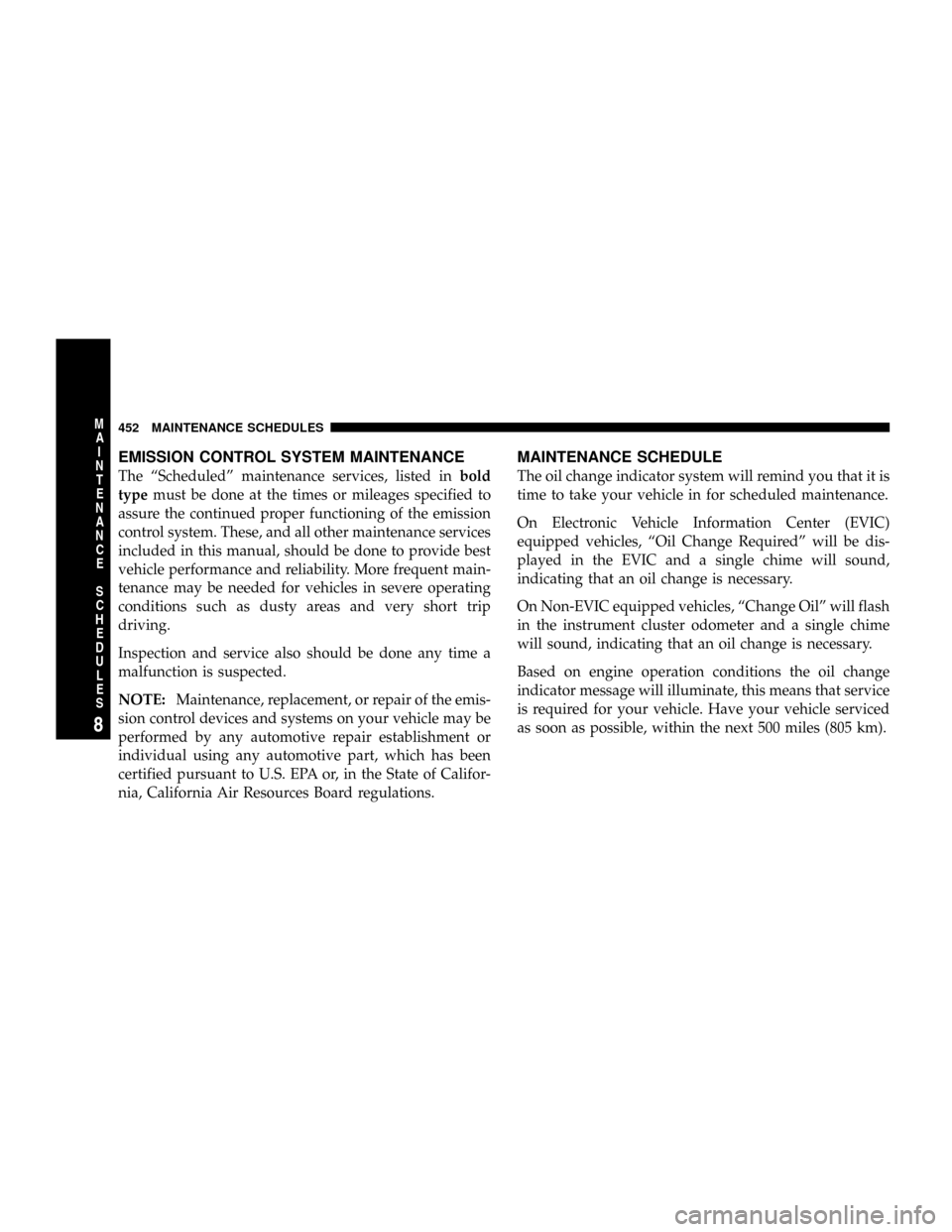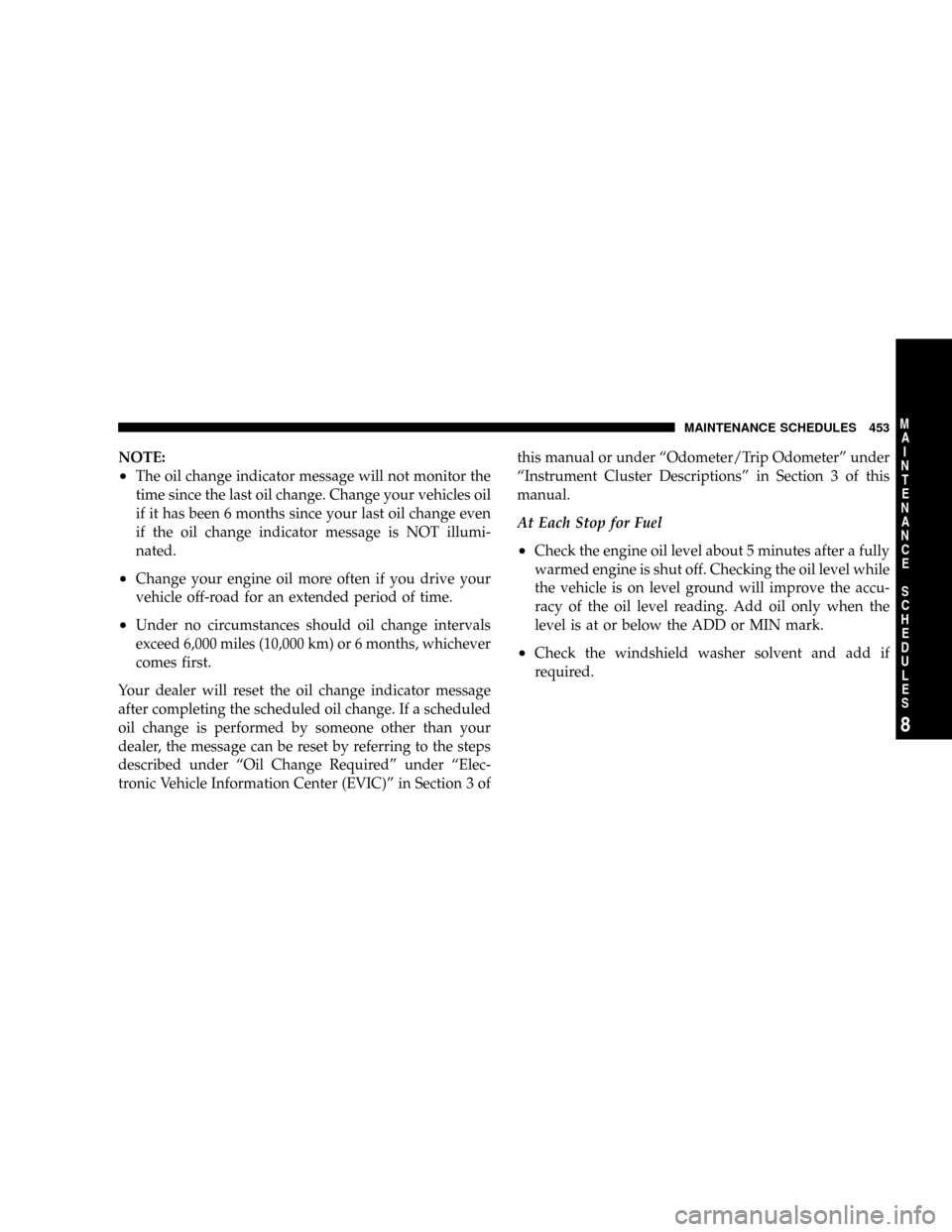Page 425 of 493

Automatic Transmission
Fluid Level Check
Your vehicle is equipped with a capped dipstick tube that
is sealed and it should not be tampered with. Your
authorized dealer has the proper tools to ensure that the
fluid level is set properly.
CAUTION!
Using a transmission fluid other than the manufac-
turer's recommended fluid may cause deterioration
in transmission shift quality and/or torque converter
shudder. Using a transmission fluid other than that
recommended by the manufacturer will result in
more frequent fluid and filter changes. Refer to
ªFluids, Lubricants, and Genuine Partsº in this sec-
tion for the correct fluid type.
Fluid and Filter Changes
Change the automatic transmission fluid and filter at the
intervals shown in the ªMaintenance Scheduleº in Sec-
tion 8 of this manual.
In addition, change the fluid and filter if the transmission
is disassembled for any reason.
NOTE:Be sure to follow the ªpolice, taxi, fleet, off-road,
or frequent trailer towingº maintenance interval if appli-
cable.
Special Additives
Automatic Transmission Fluid (ATF) is an engineered
product and its performance may be impaired by supple-
mental additives. Therefore, do not add any fluid addi-
tives to the transmission. The only exception to this
policy is the use of special dyes to aid in detecting fluid
leaks. In addition, avoid using transmission sealers as
they may adversely affect seals.
MAINTAINING YOUR VEHICLE 425
7
Page 426 of 493

Manual Transmission Ð If Equipped
Fluid Level Check
Check the fluid level by removing the fill plug. The fluid
level should be between the bottom of the fill hole and a
point not more than 3/16º (4.76 mm) below the bottom of
the hole.
Add fluid, if necessary, to maintain the proper level.
Lubricant Selection
Use only manufacturer's recommended manual trans-
mission fluid. Refer to ªFluids, Lubricants, and Genuine
Partsº in this section for the correct fluid type.
Frequency of Fluid Change
Under normal operating conditions, the fluid installed at
the factory will give satisfactory lubrication for the life of
the vehicle. Fluid changes are not necessary unless the
fluid becomes contaminated with water. Change the fluid
immediately if contaminated with water.
NOTE:Be sure to follow the ªtrailer tow, snow plow,
heavy load, taxi, police, commercial service, off-road,
desert, or sustained high speeds during hot weatherº
maintenance interval if applicable.
Transfer Case
Fluid Level Check
The fluid level should be to the bottom edge of the fill
hole (1) when the vehicle is in a level position.
426 MAINTAINING YOUR VEHICLE
Page 428 of 493

NOTE:Be sure to follow the ªpolice, taxi, fleet, off-road,
or frequent trailer towingº maintenance interval if appli-
cable.
Front/Rear Axle Fluid
Fluid Level Check
The lubricant level should be at bottom edge of the oil fill
hole.
Adding Fluid
Add lubricant only at the fill hole and only to the level
specified above.
Lubricant Selection
Use only manufacturer's recommended lubricant. Refer
to ªFluids, Lubricants, and Genuine Partsº in this section
for the correct fluid type.
Frequency of Fluid Change
Under normal operating conditions, the lubricant in-
stalled at the factory will give satisfactory lubrication forthe life of the vehicle. Lubricant changes are not neces-
sary unless the lubricant becomes contaminated with
water. Change the lubricant immediately if contaminated
with water.
NOTE:Be sure to follow the ªpolice, taxi, fleet, off-road,
or frequent trailer towingº maintenance interval if appli-
cable.
Appearance Care And Protection From Corrosion
Protection Of Body And Paint From Corrosion
Vehicle body care requirements vary according to geo-
graphic locations and usage. Chemicals that make roads
passable in snow and ice and those that are sprayed on
trees and road surfaces during other seasons are highly
corrosive to the metal in your vehicle. Outside parking,
which exposes your vehicle to airborne contaminants,
road surfaces on which the vehicle is operated, extreme
428 MAINTAINING YOUR VEHICLE
Page 429 of 493

hot or cold weather and other extreme conditions will
have an adverse effect on paint, metal trim, and under-
body protection.
The following maintenance recommendations will enable
you to obtain maximum benefit from the corrosion
resistance built into your vehicle.
What Causes Corrosion?
Corrosion is the result of deterioration or removal of
paint and protective coatings from your vehicle.
The most common causes are:
²Road salt, dirt, and moisture accumulation.
²Stone and gravel impact.
²Insects, tree sap, and tar.
²Salt in the air near seacoast localities.
²Atmospheric fallout/industrial pollutants.
²Bird droppings.
Washing
²
Wash your vehicle regularly. Always wash your ve-
hicle in the shade using MopartCar Wash or a mild
car wash soap, and rinse the panels completely with
clear water.
²If insects, tar, or other similar deposits have accumu-
lated on your vehicle, use MopartSuper Kleen Bug
and Tar Remover to remove.
²Use MopartCleaner Wax to remove road film, stains,
and to protect your paint finish. Take care never to
scratch the paint.
²Avoid using abrasive compounds and power buffing
that may diminish the gloss or thin out the paint
finish.
MAINTAINING YOUR VEHICLE 429
7
Page 433 of 493

To minimize the possibility of scratching the lenses and
reducing light output, avoid wiping with a dry cloth. To
remove road dirt, wash with a mild soap solution fol-
lowed by rinsing.
Do not use abrasive cleaning components, solvents, steel
wool or other aggressive material to clean the lenses.
Glass Surfaces
All glass surfaces should be cleaned on a regular basis
with MopartGlass Cleaner or any commercial
household-type glass cleaner. Never use an abrasive type
cleaner. Use caution when cleaning the inside rear win-
dow equipped with electric defrosters or the right rear
quarter window equipped with the radio antenna. Do
not use scrapers or other sharp instruments, which may
scratch the elements.
When cleaning the rear view mirror, spray cleaner on the
towel or rag that you are using. Do not spray cleaner
directly on the mirror.
Cleaning Plastic Instrument Cluster Lenses
The lenses in front of the instruments in this vehicle are
molded in clear plastic. When cleaning the lenses, care
must be taken to avoid scratching the plastic.
1. Clean with a wet soft rag. A mild soap solution may be
used, but do not use high alcohol content or abrasive
cleaners. If soap is used, wipe clean with a clean damp
rag.
2. Dry with a soft tissue.
Seat Belt Maintenance
Do not bleach, dye, or clean the belts with chemical
solvents or abrasive cleaners. This will weaken the fabric.
Sun damage can also weaken the fabric.
If the belts need cleaning, use a mild soap solution or
lukewarm water. Dry with a soft tissue. Do not remove
the belts from the car to wash them.
MAINTAINING YOUR VEHICLE 433
7
Page 451 of 493
MAINTENANCE SCHEDULES
CONTENTS
mEmission Control System Maintenance........452
mMaintenance Schedule...................452NRequired Maintenance Intervals...........455
8
M
A
I
N
T
E
N
A
N
C
E
S
C
H
E
D
U
L
E
S
Page 452 of 493

EMISSION CONTROL SYSTEM MAINTENANCE
The ªScheduledº maintenance services, listed inbold
typemust be done at the times or mileages specified to
assure the continued proper functioning of the emission
control system. These, and all other maintenance services
included in this manual, should be done to provide best
vehicle performance and reliability. More frequent main-
tenance may be needed for vehicles in severe operating
conditions such as dusty areas and very short trip
driving.
Inspection and service also should be done any time a
malfunction is suspected.
NOTE:Maintenance, replacement, or repair of the emis-
sion control devices and systems on your vehicle may be
performed by any automotive repair establishment or
individual using any automotive part, which has been
certified pursuant to U.S. EPA or, in the State of Califor-
nia, California Air Resources Board regulations.
MAINTENANCE SCHEDULE
The oil change indicator system will remind you that it is
time to take your vehicle in for scheduled maintenance.
On Electronic Vehicle Information Center (EVIC)
equipped vehicles, ªOil Change Requiredº will be dis-
played in the EVIC and a single chime will sound,
indicating that an oil change is necessary.
On Non-EVIC equipped vehicles, ªChange Oilº will flash
in the instrument cluster odometer and a single chime
will sound, indicating that an oil change is necessary.
Based on engine operation conditions the oil change
indicator message will illuminate, this means that service
is required for your vehicle. Have your vehicle serviced
as soon as possible, within the next 500 miles (805 km).
452 MAINTENANCE SCHEDULES
8
M
A
I
N
T
E
N
A
N
C
E
S
C
H
E
D
U
L
E
S
Page 453 of 493

NOTE:
²The oil change indicator message will not monitor the
time since the last oil change. Change your vehicles oil
if it has been 6 months since your last oil change even
if the oil change indicator message is NOT illumi-
nated.
²Change your engine oil more often if you drive your
vehicle off-road for an extended period of time.
²Under no circumstances should oil change intervals
exceed 6,000 miles (10,000 km) or 6 months, whichever
comes first.
Your dealer will reset the oil change indicator message
after completing the scheduled oil change. If a scheduled
oil change is performed by someone other than your
dealer, the message can be reset by referring to the steps
described under ªOil Change Requiredº under ªElec-
tronic Vehicle Information Center (EVIC)º in Section 3 ofthis manual or under ªOdometer/Trip Odometerº under
ªInstrument Cluster Descriptionsº in Section 3 of this
manual.
At Each Stop for Fuel
²Check the engine oil level about 5 minutes after a fully
warmed engine is shut off. Checking the oil level while
the vehicle is on level ground will improve the accu-
racy of the oil level reading. Add oil only when the
level is at or below the ADD or MIN mark.
²Check the windshield washer solvent and add if
required.
MAINTENANCE SCHEDULES 453
8
M
A
I
N
T
E
N
A
N
C
E
S
C
H
E
D
U
L
E
S